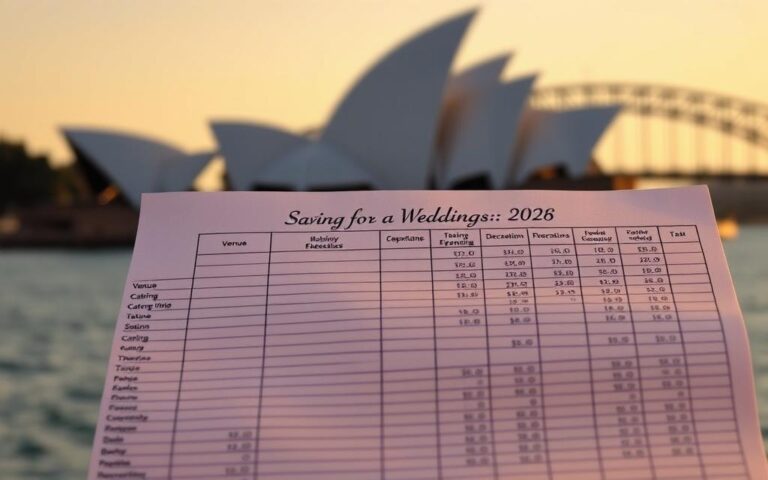adversiment
Did you know 40% of Aussies can’t cover a surprise $500 expense? An emergency fund is vital for your financial future. It’s not just a recommendation; it’s a survival strategy.
An emergency savings plan acts as your financial safety net. It provides peace of mind during unpredictable times. This fund helps with job loss, medical costs, or urgent home repairs.
This guide will help you create a solid emergency fund. We’ll explore practical strategies and set realistic savings goals. You’ll learn actionable steps to build your financial cushion.
Understanding emergency savings is key to financial resilience. Smart saving techniques will prepare you for future challenges. Let’s dive into building your emergency fund from scratch.
Understanding the Importance of an Emergency Fund
Financial security is vital for personal wealth management in Australia. A rainy day fund offers crucial protection against unexpected money challenges. It helps Aussies navigate uncertain economic times with confidence.
An emergency fund is a financial cushion for unexpected costs or income loss. It’s a key strategy for handling unforeseen money issues that can pop up.
What is an Emergency Fund?
An emergency fund is a special savings account for surprise expenses or money troubles. It provides stability during tough times, like job loss or medical emergencies.
It can also cover major home or car repairs. Unexpected family costs are another reason to have one.
Why Everyone Needs One
Money experts say building an emergency fund is essential for personal finance. Having a financial safety net can mean the difference between weathering a crisis and falling into significant debt.
| Income Level | Recommended Emergency Fund | Timeframe to Build |
|---|---|---|
| Low Income ($30,000-$50,000) | $3,000-$5,000 | 6-12 months |
| Medium Income ($50,000-$80,000) | $6,000-$10,000 | 12-18 months |
| High Income ($80,000+) | $10,000-$20,000 | 18-24 months |
Financial Emergencies to Prepare For
Knowing potential money risks helps Aussies create better emergency funds. Common issues include sudden job loss and unexpected medical treatments.
Critical home repairs or urgent vehicle maintenance are also possible emergencies to consider.
“Financial preparedness is not about predicting the future, but being ready for any potential challenge.” – Australian Financial Planning Association
Setting Your Emergency Fund Goals
A robust contingency fund in Australia needs careful planning. Your safety net fund should protect you from unexpected financial challenges. It’s a personalised shield for your finances.
Establishing emergency savings requires understanding your financial landscape. Consider these key points when setting up your fund:
- Assess your current monthly expenses in detail
- Calculate potential income disruptions
- Factor in personal risk factors
Determining Your Target Amount
Experts suggest saving 3-6 months of living expenses. Your target depends on several factors:
- Job stability
- Family dependencies
- Industry volatility
“A well-planned safety net fund is your financial insurance policy against unexpected life events.” – Australian Financial Planning Association
Duration of Fund Coverage
Your contingency fund should cushion you during potential job loss or emergencies. Build a fund that comfortably covers your essential expenses.
Assessing Your Monthly Expenses
Break down your monthly expenses carefully. Include these essential costs:
- Rent or mortgage payments
- Utility bills
- Groceries
- Transportation costs
- Healthcare expenses
A comprehensive safety net fund needs an honest evaluation of your financial needs. Start small and stay consistent. Gradually build your financial resilience over time.
Evaluating Your Current Financial Situation
Understanding your financial landscape is crucial when building cash reserves Australia. Before creating an emergency fund, you need a clear picture of your current money situation. This process helps identify opportunities to boost your emergency savings strategically.
Developing a financial overview requires examining your income streams and spending patterns. Knowing where your money comes from and goes can unlock significant savings potential.
Reviewing Your Income Sources
Your income assessment should be thorough and realistic. Consider all potential revenue channels:
- Full-time salary
- Freelance or contract work
- Investment returns
- Rental income
- Side business earnings
Tracking Your Expenses
Expense tracking is key to understanding your financial health. Use digital tools or spreadsheets to categorize spending carefully.
| Expense Category | Monthly Average | Potential Savings |
|---|---|---|
| Housing | $2,000 | $100-$200 |
| Utilities | $300 | $50-$75 |
| Food | $600 | $100-$150 |
| Transport | $250 | $30-$50 |
Identifying Potential Savings
Finding savings opportunities requires a critical eye and willingness to make changes. Look for areas where you can cut back.
- Unnecessary subscription services
- Dining out expenses
- Impulse purchasing habits
- Inefficient utility plans
“Small changes create significant financial transformations” – Australian Financial Planning Association
Evaluating your finances helps build robust cash reserves Australia. It creates a solid foundation for a sustainable emergency fund.
Choosing the Right Savings Account
Building an emergency fund in Australia requires a suitable savings account. Your choice can greatly impact fund growth for unexpected expenses. It’s crucial to understand your options carefully.
Selecting the right account involves evaluating factors that protect your financial safety net. These factors can help grow your emergency fund effectively.
Benefits of High-Interest Savings Accounts
High-interest savings accounts offer many advantages for emergency funds:
- Higher interest rates compared to standard transaction accounts
- Potential for faster fund growth
- Reduced impact of inflation on savings
- Easy online management
Comparing Online vs. Traditional Banks
Digital banking has changed savings opportunities. Online banks often provide more competitive interest rates. This is due to their lower overhead costs.
| Bank Type | Average Interest Rate | Accessibility | Account Fees |
|---|---|---|---|
| Online Banks | 3.5% – 4.5% | 24/7 Digital Access | Minimal to No Fees |
| Traditional Banks | 1.5% – 2.5% | Branch & Digital | Monthly Maintenance Fees |
Understanding Account Fees
Fees can significantly erode your emergency fund’s growth. Look for accounts with:
- No monthly account keeping charges
- No transaction fees
- No minimum balance requirements
“Your emergency fund should work for you, not against you through unnecessary fees.” – Australian Financial Expert
Choose a savings account with flexibility and competitive interest rates. Avoid unnecessary fees to boost your financial resilience.
Creating a Savings Strategy
Building emergency savings in Australia needs a smart plan. This turns good ideas into real money actions. Your rainy day fund needs a solid plan to grow well.
A strong savings strategy has many parts. These parts work together to build your money safety net.
Automating Your Savings
The best way to save is to make it automatic. Set up transfers from your main account to your emergency fund. This helps you save without thinking about it.
- Choose a fixed percentage of your income
- Align transfers with your pay cycle
- Select a high-interest savings account
Budgeting for Savings
Good budgeting is key to growing your rainy day fund. Treat your emergency fund like a must-pay bill in your monthly budget.
| Expense Category | Percentage of Income | Emergency Fund Contribution |
|---|---|---|
| Essential Living Expenses | 50-60% | 10-15% |
| Discretionary Spending | 20-30% | Potential Additional Savings |
Leveraging Windfalls and Bonuses
Surprise money can boost your emergency savings fast. Tax returns, work bonuses, and unexpected cash gifts can really help your rainy day fund.
- Commit to saving 50-75% of unexpected income
- Immediately transfer windfall amounts to your emergency fund
- Resist the temptation to spend entire bonus amounts
These strategies will help you build financial strength. You’ll be better protected against surprise expenses and tough times.
How to Start Saving for Your Emergency Fund
Building a financial buffer in Australia takes planning and dedication. Starting a contingency fund isn’t instant, but anyone can save effectively with the right approach.
Breaking the process into smaller steps makes it less overwhelming. Begin small and stay consistent for the best results.
Starting Small: Your First Steps
Saving even a little each week can create momentum. Try these initial strategies to get started.
- Set aside $20-$50 weekly from your income
- Round down purchases and save the difference
- Redirect small windfalls like tax returns
Incremental Increases: Growing Your Savings
As you gain financial confidence, slowly increase your contributions. Try to boost your savings by 1-2% every few months.
This method helps build your contingency fund without feeling too much pressure.
Tips for Consistent Saving
Keeping a financial buffer requires discipline. Here are some practical saving techniques to try:
- Automate your savings transfers
- Create a dedicated high-interest savings account
- Track your progress using budgeting apps
Remember, every dollar saved is a step towards financial security.
Maintaining Your Emergency Fund
Smart management of your safety net fund is crucial. Cash reserves in Australia need careful planning for both saving and using.
Your emergency fund protects you during tough times. It’s important to know how to use it wisely.
Knowing When to Use Your Fund
Use your safety net only for real emergencies. These may include:
- Unexpected medical expenses not covered by Medicare
- Critical home or vehicle repairs
- Sudden job loss or significant income reduction
- Emergency travel for family crisis
Avoiding Frequent Withdrawals
Don’t use your cash reserves for non-essential items. Stick to your plan to keep your financial safety net intact.
| Withdrawal Scenario | Recommended Action |
|---|---|
| Non-essential purchase | Avoid using emergency fund |
| Genuine emergency | Carefully document and assess withdrawal |
| Partial income loss | Use strategically and sparingly |
Regular Fund Reviews
Check your emergency fund often to ensure it meets your needs. Aim to review your fund annually or after significant life changes.
- Check if the fund covers 3-6 months of living expenses
- Adjust for inflation and income changes
- Replenish funds after emergency use
Stay disciplined with your emergency fund. It will protect you when life throws unexpected challenges your way.
Growing Your Emergency Fund Over Time
Building an emergency fund in Australia needs a smart plan. Your fund should grow as your income and life change. It’s a dynamic tool, not a static resource.
- Set up automatic monthly transfers to your dedicated savings account
- Align contributions with your pay cycle
- Commit to increasing savings by a small percentage each year
Developing a Consistent Contribution Plan
Regular contributions are vital for growing your emergency fund. Choose a realistic monthly amount you can save comfortably. Even small, regular deposits can accumulate significant savings over time.
Scaling Contributions with Income Growth
Boost your emergency fund as your income grows. When you get a pay rise, put some of that extra money into savings. This helps your safety net grow along with your earnings.
Exploring Additional Income Streams
Speed up your fund’s growth with extra income sources. Look into freelance work, online platforms, or part-time jobs. These can provide more money for your emergency savings.
- Freelance writing or graphic design
- Online tutoring
- Weekend retail or hospitality shifts
- Digital marketplace selling
Your emergency fund is a crucial financial buffer. It needs ongoing care and smart planning. Using these strategies will help build a strong safety net for changing life situations.
Common Mistakes to Avoid
Building an emergency savings strategy in Australia requires careful planning. Many Aussies make errors that can harm their financial safety net. These mistakes can weaken their long-term financial security.
Understanding these pitfalls is crucial for maintaining a strong emergency fund. A robust fund provides real financial protection during unexpected events.
Using Your Emergency Fund for Non-Emergencies
The biggest risk to your emergency fund is using it for non-essential expenses. Australians often consider using their emergency savings for fun activities.
- Spontaneous holidays
- Luxury purchases
- Discretionary shopping
- Dining out frequently
Underestimating Your Financial Needs
Many Aussies miscalculate the true cost of potential emergencies. Living expenses in Sydney and Melbourne are high. Your emergency fund should cover more than you might think.
| Emergency Type | Estimated Cost | Recommended Coverage |
|---|---|---|
| Medical Expenses | $5,000 – $15,000 | Full amount |
| Job Loss | 3-6 months of income | Complete salary replacement |
| Major Car Repair | $2,000 – $6,000 | Full repair costs |
Neglecting Regular Strategy Reviews
Your emergency fund strategy isn’t a set-and-forget solution. Regular reviews keep your savings aligned with your current financial situation. They also help adjust for potential risks.
- Reassess every 6-12 months
- Update based on income changes
- Adjust for inflation
- Consider life stage transitions
Keep a disciplined and strategic approach to your emergency savings. This will help you build and maintain a strong fund. A robust emergency fund truly protects your financial future.
The Psychological Benefits of an Emergency Fund

A rainy day fund in Australia is more than just financial planning. It’s a powerful tool for mental well-being and financial confidence. Having a solid financial buffer can change how we face unexpected challenges.
Financial stress can be overwhelming in Australia’s changing economy. An emergency fund acts as a shield. It reduces anxiety and provides security during uncertain times.
Reducing Financial Stress
Aussies face many money pressures, from job changes to sudden medical costs. A good emergency fund offers mental relief by:
- Minimizing panic during financial uncertainties
- Creating a sense of control over personal finances
- Reducing emotional strain during challenging periods
Providing Peace of Mind
Knowing you have a financial safety net is incredibly comforting. Peace of mind becomes a tangible benefit of disciplined saving. This mental advantage helps us face life’s challenges with more resilience and confidence.
Encouraging Financial Discipline
Building an emergency fund takes consistent effort and planning. This process naturally develops important money skills:
- Improved budgeting techniques
- Enhanced financial decision-making
- Stronger long-term financial habits
By focusing on a rainy day fund, Aussies invest in both financial security and mental health. It’s a smart move that pays off in more ways than one.
Conclusion: Taking Action
Building a contingency fund in Australia needs commitment and planning. Your financial security starts with small, consistent steps. A safety net fund creates resilience against unexpected money challenges.
Start by opening a high-interest savings account for your emergency needs. Set realistic goals, like saving $500 or one week’s salary. Gradually increase your contributions as your confidence grows.
Discipline is key to successful financial planning. Automate your savings and track your progress. Focus on your long-term goals for greater financial stability.
Every dollar saved is a step towards financial peace of mind. Your future self will thank you for being proactive today.
By using these strategies, you’re investing in your financial resilience. Stay motivated and consistent. Watch your safety net grow into a robust financial shield.
FAQ
What exactly is an emergency fund?
How much money should I aim to save in my emergency fund?
Where is the best place to keep my emergency fund in Australia?
How quickly can I build an emergency fund?
What counts as a genuine emergency?
Can I use my emergency fund for tax returns or work bonuses?
What if I can’t save a full 3-6 months of expenses immediately?
FAQ
What exactly is an emergency fund?
An emergency fund is a savings account for unexpected expenses. It’s a financial safety net for tough times. Aussies typically save 3-6 months of living expenses for unforeseen events.
How much money should I aim to save in my emergency fund?
The ideal amount depends on your situation. Experts suggest saving 3-6 months of living expenses. For average Australians, this could be ,000 to ,000, based on location and lifestyle.
Where is the best place to keep my emergency fund in Australia?
A high-interest savings account is usually best. Look for competitive rates from reputable Australian banks. Choose an account with easy access and good interest earnings.
How quickly can I build an emergency fund?
Building an emergency fund takes time and effort. Start by saving 5-10% of your income. Many Aussies succeed by automating savings and increasing contributions over time.
What counts as a genuine emergency?
True emergencies include unexpected medical costs, urgent car repairs, and sudden job loss. Non-emergencies are planned expenses like holidays or regular car maintenance. Use the fund only for unexpected, essential expenses.
Can I use my emergency fund for tax returns or work bonuses?
Use tax returns or work bonuses to boost your emergency savings instead. These windfalls can help grow your fund without affecting your regular budget.
What if I can’t save a full 3-6 months of expenses immediately?
Don’t worry. Start small and be consistent. Even saving 0-
FAQ
What exactly is an emergency fund?
An emergency fund is a savings account for unexpected expenses. It’s a financial safety net for tough times. Aussies typically save 3-6 months of living expenses for unforeseen events.
How much money should I aim to save in my emergency fund?
The ideal amount depends on your situation. Experts suggest saving 3-6 months of living expenses. For average Australians, this could be $10,000 to $25,000, based on location and lifestyle.
Where is the best place to keep my emergency fund in Australia?
A high-interest savings account is usually best. Look for competitive rates from reputable Australian banks. Choose an account with easy access and good interest earnings.
How quickly can I build an emergency fund?
Building an emergency fund takes time and effort. Start by saving 5-10% of your income. Many Aussies succeed by automating savings and increasing contributions over time.
What counts as a genuine emergency?
True emergencies include unexpected medical costs, urgent car repairs, and sudden job loss. Non-emergencies are planned expenses like holidays or regular car maintenance. Use the fund only for unexpected, essential expenses.
Can I use my emergency fund for tax returns or work bonuses?
Use tax returns or work bonuses to boost your emergency savings instead. These windfalls can help grow your fund without affecting your regular budget.
What if I can’t save a full 3-6 months of expenses immediately?
Don’t worry. Start small and be consistent. Even saving $500-$1,000 as an initial buffer can help. The key is to begin saving and build your fund over time.
How often should I review my emergency fund?
Review your emergency fund yearly or after major life changes. This includes new jobs, marriage, having kids, or changes in expenses. Ensure your fund stays adequate for your current situation.
Are there any tax implications for emergency fund savings?
Interest earned on your emergency fund is usually taxable income. The benefits of a financial safety net outweigh any tax issues. Consult a financial advisor for personalised advice.
What’s the biggest mistake people make with emergency funds?
The most common mistake is using the fund for non-emergencies. Another error is not replenishing it after use. Treat your emergency fund as a vital financial tool.
,000 as an initial buffer can help. The key is to begin saving and build your fund over time.
How often should I review my emergency fund?
Review your emergency fund yearly or after major life changes. This includes new jobs, marriage, having kids, or changes in expenses. Ensure your fund stays adequate for your current situation.
Are there any tax implications for emergency fund savings?
Interest earned on your emergency fund is usually taxable income. The benefits of a financial safety net outweigh any tax issues. Consult a financial advisor for personalised advice.
What’s the biggest mistake people make with emergency funds?
The most common mistake is using the fund for non-emergencies. Another error is not replenishing it after use. Treat your emergency fund as a vital financial tool.



